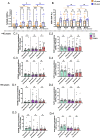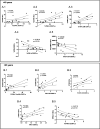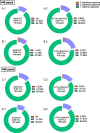The use of alpha 1 thymosin as an immunomodulator of the response against SARS-Cov2
- PMID: 37408063
- PMCID: PMC10320944
- DOI: 10.1186/s12979-023-00351-x
The use of alpha 1 thymosin as an immunomodulator of the response against SARS-Cov2
Abstract
Background: Since the beginning of SARS-CoV2 pandemic, the mortality rate among elderly patients (60-90 years) has been around 50%, so age has been a determining factor of a worse COVID-19 prognosis. Associated with age, the thymic function involution and depletion plays an important role, that could be related to a dysregulated and ineffective innate and adaptive immune response against SARS-CoV2. Our study aims to further in vitro effect of human Thymosin-alpha-1 (α1Thy) treatment on the immune system in population groups with different thymic function levels in the scenario of SARS-CoV2 infection.
Results: Activation markers such as CD40, CD80 and TIM-3 were upregulated in α1Thy presence, especially in plasmacytoid dendritic cells (pDCs) and, with increased TNFα production was observed compared to untreated condition. Co-cultures of CD4 + and CD8 + T cells with DCs treated with α1Thy in response to SARS-CoV2 peptides showed a decrease in the cytokine production compared to the condition without α1Thy pre-treated. A decrease in CD40L activation co-receptor expression in CD8 + LTs was also observed, as well as an increase in PD1 in CD4 + TLs expression in both age groups. In fact, there are no age-related differences in the immunomodulatory effect of the hormone, and it seems that effector memory and terminally differentiated memory T lymphocyte subsets were the most actively influenced by the immunomodulatory α1Thy effect. Finally, the polyfunctionality measured in SARS-CoV2 Specific-T cells response was maintained in α1Thy presence in total and memory subpopulations CD4 + and CD8 + T-cells, despite decreased proinflammatory cytokines production.
Conclusion: The hormone α1Thy could reduce, through the modulation of DCs, the amount of proinflammatory cytokines produced by T cells. Moreover, α1Thy improve lymphocyte functionality and could become a beneficial therapeutic alternative as an adjuvant in SARS-CoV2 treatment either in the acute phase after infection or reinfection. In addition, the effect on the T immune response means that α1Thy can be incorporated into the vaccination regimen, especially in the most immunologically vulnerable individuals such as the elderly.
Subjects: Thymosin alpha 1, Dendritic cells, SARS-CoV2-specific T cells response, Immunomodulation.
© 2023. The Author(s).
Conflict of interest statement
The authors declare no competing interests.
Figures







Similar articles
-
Immune modulation via dendritic cells by the effect of Thymosin-alpha-1 on immune synapse in HCMV infection.Int Immunopharmacol. 2023 Dec;125(Pt A):111103. doi: 10.1016/j.intimp.2023.111103. Epub 2023 Oct 31. Int Immunopharmacol. 2023. PMID: 38149577
-
SARS-Cov2 acute and post-active infection in the context of autoimmune and chronic inflammatory diseases.J Transl Autoimmun. 2022;5:100154. doi: 10.1016/j.jtauto.2022.100154. Epub 2022 Apr 12. J Transl Autoimmun. 2022. PMID: 35434592 Free PMC article.
-
SARS-CoV2 wild type and mutant specific humoral and T cell immunity is superior after vaccination than after natural infection.PLoS One. 2022 Apr 25;17(4):e0266701. doi: 10.1371/journal.pone.0266701. eCollection 2022. PLoS One. 2022. PMID: 35468147 Free PMC article.
-
GSK-3 Inhibition as a Therapeutic Approach Against SARs CoV2: Dual Benefit of Inhibiting Viral Replication While Potentiating the Immune Response.Front Immunol. 2020 Jun 26;11:1638. doi: 10.3389/fimmu.2020.01638. eCollection 2020. Front Immunol. 2020. PMID: 32695123 Free PMC article. Review.
-
Functional Signatures of Human CD4 and CD8 T Cell Responses to Mycobacterium tuberculosis.Front Immunol. 2014 Apr 22;5:180. doi: 10.3389/fimmu.2014.00180. eCollection 2014. Front Immunol. 2014. PMID: 24795723 Free PMC article. Review.
Cited by
-
Enhanced Immunomodulatory Effects of Thymosin-Alpha-1 in Combination with Polyanionic Carbosilane Dendrimers against HCMV Infection.Int J Mol Sci. 2024 Feb 6;25(4):1952. doi: 10.3390/ijms25041952. Int J Mol Sci. 2024. PMID: 38396631 Free PMC article.
-
Phenotypic drug discovery: a case for thymosin alpha-1.Front Med (Lausanne). 2024 Jun 6;11:1388959. doi: 10.3389/fmed.2024.1388959. eCollection 2024. Front Med (Lausanne). 2024. PMID: 38903817 Free PMC article. Review.
-
Thymosin alpha 1 alleviates inflammation and prevents infection in patients with severe acute pancreatitis through immune regulation: a systematic review and meta-analysis.Front Immunol. 2025 Jun 17;16:1571456. doi: 10.3389/fimmu.2025.1571456. eCollection 2025. Front Immunol. 2025. PMID: 40599771 Free PMC article.
-
Effect of thymosin α1 on Immune response and organ function in acute aortic dissection surgery: PANDA II trial protocol.Future Cardiol. 2025 Jun;21(7):447-454. doi: 10.1080/14796678.2025.2505401. Epub 2025 May 14. Future Cardiol. 2025. PMID: 40367062 Clinical Trial.
References
Grants and funding
LinkOut - more resources
Full Text Sources
Research Materials
Miscellaneous

